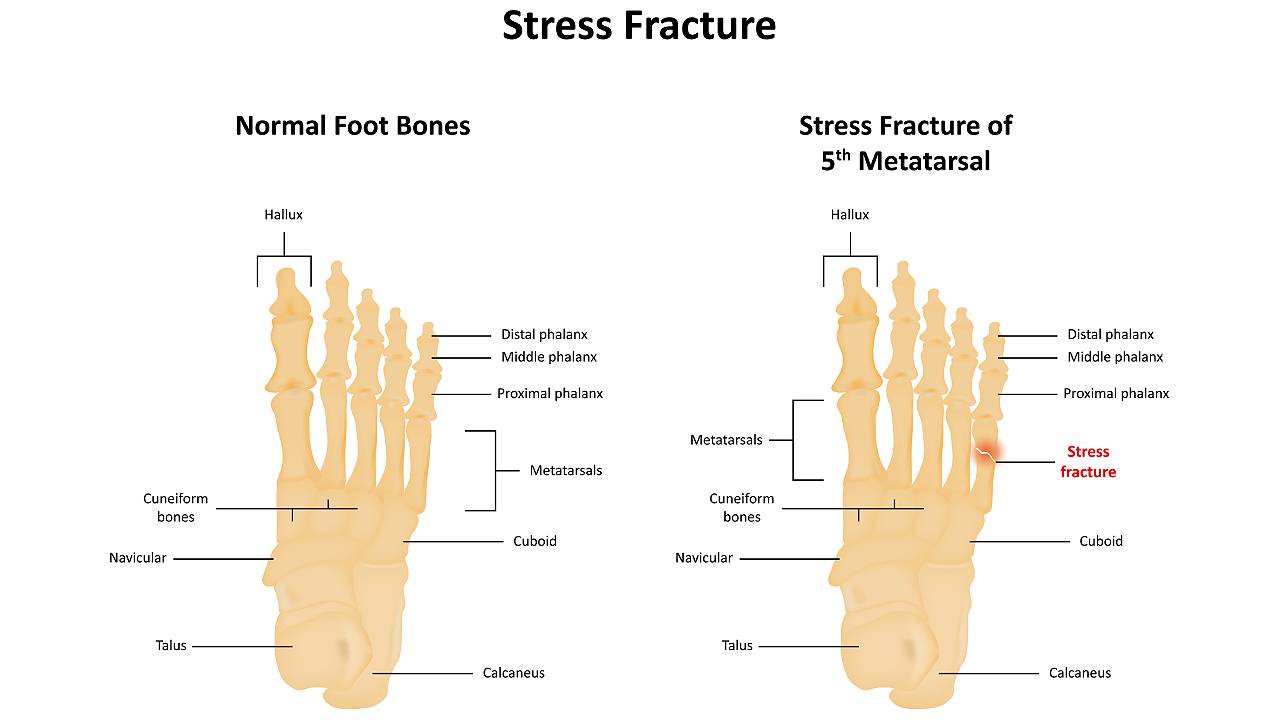
A stress fracture is a term applied to bone injuries in the foot that are tiny cracks in the bone. It is caused by repetitive stress on the foot, typically caused by activities such as jumping or running long distances. They are sometimes known as march fractures as they are a common occurrence among those serving in the military due to frequent running, jumping and other high impact activities.
The difference between stress fractures and regular fractures are that stress fractures are caused by repetitive stress rather than a single traumatic event. They can occur in multiple areas of the lower limbs, with the second and third metatarsal, the heel, and fibula being some of the common areas of injury.
Causes
The most common cause of stress fractures is a sudden increase in intensity or frequency of activity or doing too much physical activity in a short period of time. Our bones are constantly renewing themselves through a process called remodeling, when there is insufficient rest or too much activity, the stress created by these activities can wear out the bones faster than our bodies can repair and replace them. This causes the bone to weaken and vulnerable to stress fractures.
Female Athlete Triad
Some research has also suggested that women are more likely to develop stress fractures. One increasingly common cause of these injuries is the Female Athlete Triad which is a combination of three factors.
- Energy availability
- Bone mineral density
- Menstrual function
Due to changes in dietary preferences or eating disorders, some women are unable to take in enough calorie energy for their bodies. This can directly impact their musculoskeletal development and growth, as well as their menstrual cycles. The combination of these factors can be an indicator of stress fractures, so these issues can be medically relevant for achieving an accurate diagnosis.
Symptoms
The most common symptom of a stress fracture is pain during activity. The pain usually begins at the same spot and stops when activity is ceased. Other indicators include swelling on the top of the foot or on the outside of the ankle, tenderness to touch and bruising.
Who is at risk?
As the name suggests march or stress fractures can be caused by sudden increases in physical activity such as running, jogging or even walking. Often patients who start a new workout program or begin training for events such as marathons or distance running are at risk of developing stress fractures.
Footwear that is flimsy or worn out, or an underlying biomechanical condition such as hypermobility or a tendonitis can reduce your foots ability to absorb the repetitive forces as your foot strikes the ground, consequently causing stress fractures.
A stress fracture will be very painfully and will be worse when weight-bearing such as when standing. Often acute stress fractures can be swollen and bruised.
Patients which bone insufficiency conditions such as Osteoporosis, patients who are undertaking extreme diets or have Vitamin D insufficiency are at a greater risk of stress fractures as the bone density is often reduced.
Women suffering from the Female Athlete Triad are particularly susceptible and should take care to see a podiatrist should there be any discomfort as their bodies are more susceptible to these injuries.
How is a stress fracture diagnosed?
A thorough medical history helps your clinician see if any lifestyle choices, previous medical conditions, or other relevant data may pose certain risk factors. This is followed by a physical examination where the podiatrist will locate the area of pain and assess for damaged structures.
Once a specific area has been pinpointed, diagnostic ultra-sound imaging may be used to assess the internal structures of your body for any damage and swelling around the bone that is commonly associated with a suspected stress fracture. In some cases, your podiatrist may request for X-ray investigation to provide detailed images of the bone and check for any bone callus or breaks in the cortex of the bone as this may also be suggestive of stress fracture.

What can your podiatrist do to help?
The aim of podiatric intervention for stress fracture is to allow your body to heal and return to normal activity as soon as possible. While stress fractures are often caused over time, they can also be acute or chronic depending on when injury was sustained. In the first 12-14 Hours after a stress fracture, it is advisable to avoid bearing weight on the affected limb, elevate the foot and apply cold compress.
Bone healing usually takes around 6 – 12 weeks in adults, while children are able to heal slightly faster. Conservative therapies such as shockwave therapy or SIS can speed up the recovery process by stimulating the body’s natural healing abilities and encouraging blood flow. For more severe cases, you may also be prescribed you a custom cast or boot to offload and reduce any weight through the area.
The long-term goal for managing a stress fracture is to prevent it from happening again. This may be achieved through the use of custom foot orthosis to manage and redistribute pressure. This prevents overloading the affected area which is typically how the injury recurs.
Heeding your podiatrist’s advice is essential for full recovery and preventing future injuries.





